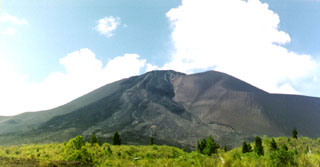Report on Soputan (Indonesia) — 22 August-28 August 2012
Smithsonian Institution / US Geological Survey
Weekly Volcanic Activity Report, 22 August-28 August 2012
Managing Editor: Sally Sennert.
Please cite this report as:
Global Volcanism Program, 2012. Report on Soputan (Indonesia) (Sennert, S, ed.). Weekly Volcanic Activity Report, 22 August-28 August 2012. Smithsonian Institution and US Geological Survey.
Soputan
Indonesia
1.112°N, 124.737°E; summit elev. 1785 m
All times are local (unless otherwise noted)
CVGHM reported that the Alert Level for Soputan had been lowered to 2 (on a scale of 1-4) on 26 June. Seismicity increased during 8-22 August; on 23 August volcanic earthquakes and avalanches significantly increased. White plumes rose 50-150 m above the crater. An eruption at 1936 on 26 August ejected incandescent tephra 50 m above the crater and produced a plume that rose 1 km and drifted W. The Alert Level was raised to 3.
Based on information from CVGHM, NOAA, and analysis of satellite imagery, the Darwin VAAC reported that on 27 August an ash plume rose to an altitude of 12.1 km (40,000 ft) a.s.l. and drifted 150 km W. The eruption lasted four hours. Later, a plume detected in satellite imagery rose to an altitude of 6.1 km (20,000 ft) a.s.l. On 28 August an ash plume drifted 220 km SW at an altitude of 6.1 km (20,000 ft) a.s.l.
Geological Summary. The Soputan stratovolcano on the southern rim of the Quaternary Tondano caldera on the northern arm of Sulawesi Island is one of Sulawesi's most active volcanoes. The youthful, largely unvegetated volcano is the only active cone in the Sempu-Soputan volcanic complex, which includes the Soputan caldera, Rindengan, and Manimporok (3.5 km ESE). Kawah Masem maar was formed in the W part of the caldera and contains a crater lake; sulfur has been extracted from fumarolic areas in the maar since 1938. Recent eruptions have originated at both the summit crater and Aeseput, a prominent NE-flank vent that formed in 1906 and was the source of intermittent major lava flows until 1924.
Sources: Pusat Vulkanologi dan Mitigasi Bencana Geologi (PVMBG, also known as CVGHM), Darwin Volcanic Ash Advisory Centre (VAAC)

